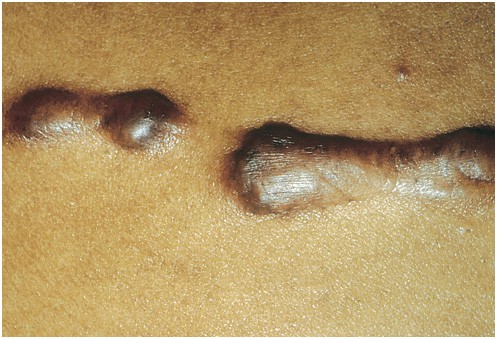Keloid: A scar that doesn’t know when to stop. When the skin is injured, cells grow back to fill in the gap. Somehow, they normally “know” when the scar tissue is level with the skin, at which point the cells stop multiplying. When the cells keep on reproducing, the result is a what is called a overgrown (hypertrophic) scar or a keloid — a tough heaped-up scar that rises quite abruptly above the rest of the skin. It is irregularly shaped and tends to enlarge progressively.

In other words, keloids are due to an excessive response to trauma such as a cut to the skin. In creating a normal scar, connective tissue in the skin is repaired by the formation of collagen. This occurs in the dermis (the layer of skin just below the epidermis, the outer layer of skin). Keloids arise when there is too much collagen formed in the dermis during the repair of connective tissue.
To develop keloids, a person must be susceptible to keloid formation. This susceptibility is clearly genetic. For instance, keloids are known to have occurred in 5 successive generations within a single family.
People of African or Asian descent are more likely to get keloids than people with lighter skin. These peoples tend to have keloid susceptibility genes. This tendency to form keloids is important when someone of African or Asian descent is considering elective plastic surgery; the surgery can cause more trouble than it cures.